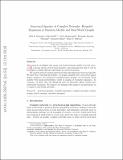Structural sparsity of complex networks: Bounded expansion in random models and real-world graphs
Author(s)
Demaine, Erik D
DownloadSubmitted version (1.252Mb)
Publisher with Creative Commons License
Publisher with Creative Commons License
Creative Commons Attribution
Terms of use
Metadata
Show full item recordAbstract
This research establishes that many real-world networks exhibit bounded expansion2, a strong notion of structural sparsity, and demonstrates that it can be leveraged to design efficient algorithms for network analysis. Specifically, we give a new linear-time fpt algorithm for motif counting and linear time algorithms to compute localized variants of several centrality measures. To establish structural sparsity in real-world networks, we analyze several common network models regarding their structural sparsity. We show that, with high probability, (1) graphs sampled with a prescribed sparse degree sequence; (2) perturbed bounded-degree graphs; (3) stochastic block models with small probabilities; result in graphs of bounded expansion. In contrast, we show that the Kleinberg and the Barabási–Albert model have unbounded expansion. We support our findings with empirical measurements on a corpus of real-world networks.
Date issued
2019-11Department
Massachusetts Institute of Technology. Department of Electrical Engineering and Computer ScienceJournal
Journal of Computer and System Sciences
Publisher
Elsevier BV
Citation
Demaine, Erik D. et al. “Structural sparsity of complex networks: Bounded expansion in random models and real-world graphs.” Journal of Computer and System Sciences, 105 (November 2019): 199-241 © 2019 The Author(s)
Version: Original manuscript
ISSN
0022-0000